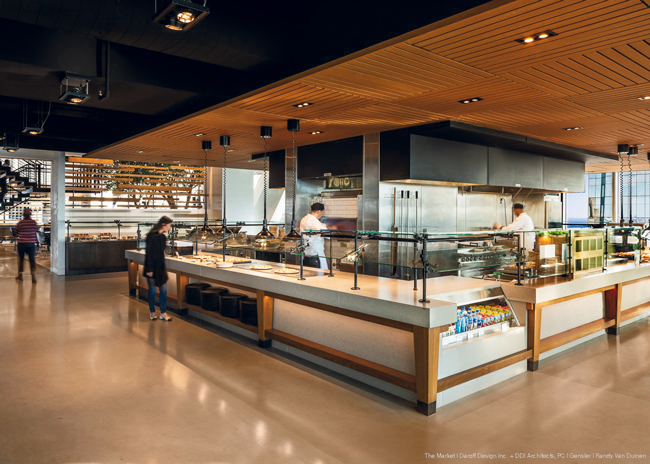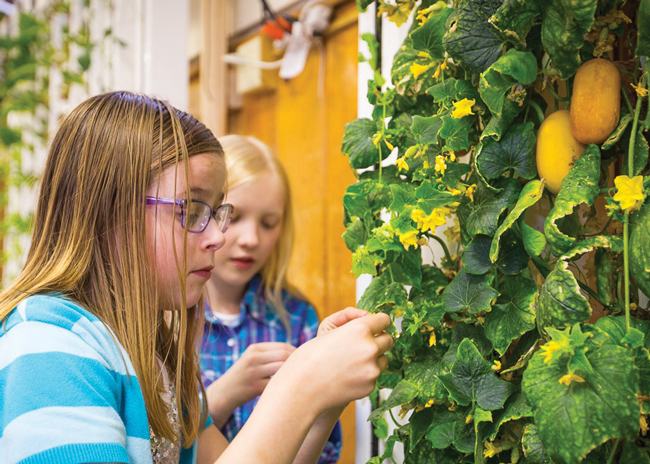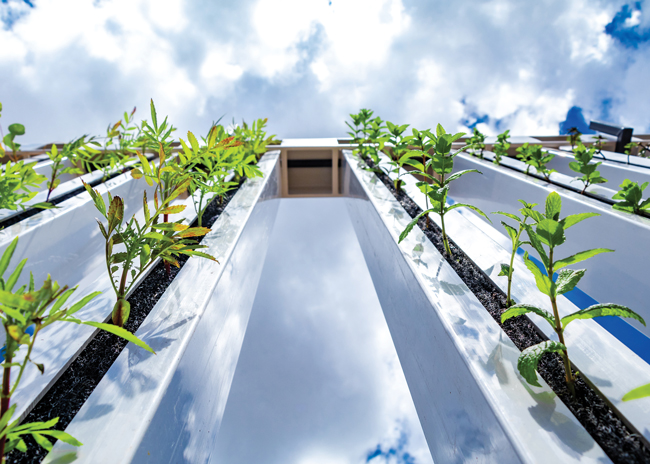Hyperlocal food has become a key trend in the foodservice industry.
While rooftop and soil-based gardens certainly offer a traditional approach for growing on-site, they tend to require a lot of real estate, collaboration with architects and engineers due to structural and weight constraints, and a full-time gardener or manager to work against bad weather and pests. That’s why more operators now use hydroponics, which some deem an easier, cleaner — and sometimes cheaper — way to grow food on-site.
“When you don’t have a controlled environment, which is the case of soil farms, you have to deal with harsh weather and might have to stop growing during parts of the year,” says Melanie Corey-Ferrini, an FCSI consultant and sustainability advisor. With Controlled Environment Agriculture (CEA), the umbrella term for hydroponics, aeroponics, aquaponics and greenhouse systems, the growing environment spans 365 days a year, 24 hours a day.
Green (or living) walls were perhaps the first iteration of herbs and lettuces grown indoors at a restaurant, but even those come with complications, from low-yield crops to limitations in the kinds of vegetables that would grow to health department restrictions. “You do not want your entire wall to suddenly appear barren during a harvesting cycle, so customarily, only about a third of the surface space on a wall is dedicated to edible applications, and the remainder is usually decorative,” says Kevin Banas, FCSI, project manager, Cini-Little International Inc.
The number of hydroponic solutions on the market has increased since the early days and the costs have decreased. “There are a number of companies now making enclosed cabinets that grow produce vegetables like microgreens, herbs and salad greens using nutrient-enhanced water and LED sun lights to optimize growth,” says Banas, who notes that many of today’s systems also integrate well with technology solutions which allow operators to monitor growth and send alerts and notifications remotely when it is time to harvest the plants. This takes the guesswork out of the process and makes it easier for anyone in the operation — green thumb or not — to manage the production.
 Growing boxes along the large expanse of windows add an element of freshness to this space. Photo courtesy of Cini-Little
Growing boxes along the large expanse of windows add an element of freshness to this space. Photo courtesy of Cini-Little
Sourcing and Specifying Hydroponics
As a foodservice designer, it behooves one to learn more about the various hydroponic solutions out there, even if it’s not always the designer’s job to specify the system itself. “There is such a push these days for things to be locally sourced and healthsome and fresh,” Corey-Ferrini says. With hydroponics, “you do end up with produce that’s slightly cheaper in the long run, but I don’t think you can put a dollar on the amount of goodwill it generates with customers.”
 Image courtesy of ZipgrowHydroponic systems are also easier to source these days, says Corey-Ferrini, who worked with high-tech business and industry clients to install such systems in the early days of the hydroponics. “Eight to 10 years ago, there wasn’t a lot of great equipment for small-scale growing, only big commercial and industrial equipment or custom solutions,” she says.
Image courtesy of ZipgrowHydroponic systems are also easier to source these days, says Corey-Ferrini, who worked with high-tech business and industry clients to install such systems in the early days of the hydroponics. “Eight to 10 years ago, there wasn’t a lot of great equipment for small-scale growing, only big commercial and industrial equipment or custom solutions,” she says.
When COVID-19 hit, suddenly there was an overflow of this equipment sitting unused since everyone was working at home. That’s when Corey-Ferrini founded the Indoor Farm Collaborative, a nonprofit organization, hydroponic facility and training ground for future farmers.
“I reached out to some high-tech clients and asked if they would be willing to donate their [hydroponic] equipment to the collaborative, which they did,” says Corey-Ferrini. She was also part of the team, in collaboration with elite studio e, that won the Foodservice Pioneering Concept competition in 2020 for its prototype fast-casual concept designed with hydroponics in mind.
Hydroponic systems, Corey-Ferrini says, “might not supply all the produce [an operator] needs, but it definitely provides a nice supplement, and there’s the whole sustainability aspect of it where you essentially create your own food supply.”
Banas notes that “many manufacturers design their hydroponic cabinet to accept seed pods of their own design, compelling you to order refills from them when it’s time to start growing a new crop.”
Many hydroponic solutions on the market come with built-in temperature and humidity controls. When using towers or systems in more open spaces, consultants work with the architect or contractor to ensure the right indoor air environment, even designing in custom glass enclosures if necessary. “If you put [the hydroponic system] in the front of the house and you’re in a warmer climate and have open doors and windows, you attract pests, so you might still want to put it behind glass so it’s visible but not open to the public,” Corey-Ferrini says.
Designing for Hydroponics
The first step when it comes to designing for hydroponics — like with other systems and equipment — is to understand the menu. “What are the opportunities on the menu for certain ingredients, and what can be grown indoors?” Corey-Ferrini asks her clients. A menu with salads or dishes using lettuces, greens, herbs, microgreens and even edible flowers, might benefit from growing these ingredients hydroponically. That same method is far less common, however, when it comes to growing foods like broccoli, tomatoes and strawberries.
“Once you’ve understood the menu, you have to think about how much space you have for hydroponics,” says Corey-Ferrini. “Do you have extra space at the back of the house, or is this going to be taking up part of the front of the house because it’s also serving as a design feature? How can you create a functional system, but one that’s part of your brand?” Once again, this is where the common sense use of glass walls or other transparent designs meant to showcase hydroponic towers and cabinets comes into play. Hydroponics can be smaller in scale, taking up just the space of one or two reach-in refrigerators, about 48 inches deep by 48 inches wide, or they can span more square footage. Of course, vertical systems in the form of hydroponic towers offer the most space-saving capability.
While Banas says green and growing systems are not always something he will include in his submitted drawings, he does work with the interior designer or architect to take those systems into account and will sometimes be the one to specify the cabinets. “We’re not responsible for laying it out in design, but that doesn’t mean we [foodservice designers] don’t become the advocate for the architect or interior designer,” he says. “The interior designer might not be terribly interested in a chef or operator’s vision for using hyperlocal produce; if that’s the case, it’s our job as consultants to advocate for them.”
Corey-Ferrini also sees the importance of collaboration when designing green spaces. “If you have a larger team of core and shell architects, it can be as simple as making sure there is a regular wall outlet,” she says, noting that most hydroponic systems only require light and a regular source of water to grow greens. “And you’ll want a water source somewhat close to allow [the operator] to fill up the reservoir.” If the hydroponic system is open to the public, it will have to be enclosed or behind doors or glass so customers don’t have direct contact with it, in adherence to health department regulations.
 Hydroponic towers require only water and light. Photo courtesy of Zipgrow
Hydroponic towers require only water and light. Photo courtesy of Zipgrow
Hydroponic Maintenance
Many of today’s hydroponic systems come with built-in cameras and their own management software, which, Banas says, “is sort of ‘idiot-proof,’ but it does leave you reliant on a subscription service, just like you’re reliant on the maker’s proprietary seedling pod refills.”
While some operators might want a hydroponic system for their own use on the menu, universities, B&I operators and even healthcare facilities might want larger systems for educational purposes or even to supply other organizations. “In that case, you might want a more robust management system, one that will tell you when your water is low or pH levels are off or when it’s time to harvest,” says Corey-Ferrini. After harvest, it’s up to the operator to “replant” or replace the empty cells or pods with new seedling pods. “Typically, the whole equipment needs to be cleaned every two or three months, where you take everything apart, clean and sanitize all the pieces and put them back,” she says.
When harvesting product from hydroponic systems, operators should follow food-handling measures. “Hyperlocal sourcing does not guarantee safety, nor does it excuse poor food handling,” Banas says. “Though you may have lovingly grown those heirloom strawberries yourself, all produce should still be washed, dried and stored in appropriate fashion.”
It might be useful to specify and install a separate, three-compartment sink near the hydroponic system for washing produce. “There are some great, dedicated stations for fresh vegetable washing nowadays that involve some keen technology, like power soak, three-compartment sinks that gently tumble delicate product like raspberries, and then there are electronic salad spinners that will rinse and dry delicate lettuces,” says Banas. He’s also an advocate of ozone generators that sterilize vegetables without the use of chemicals or other chlorine. Of course, the benefit of hydroponics is that they don’t require soil, pesticides or insecticides, but still, it’s important to wash everything thoroughly before commercial use, he says. Also, ozone generators for walk-in coolers can help prevent certain fruits and vegetables from browning or over-ripening others, he says.
Today, with so many more full-solution hydroponic systems on the market offering their own seedling, software and other built-in maintenance, growing fresh produce on-site has never been easier. Still, there’s some due diligence required in terms of researching, sourcing, specifying and designing for these sustainable solutions.
A Hydroponics Case Study: Denver Farm and Market
Avid gardener Davis Breedlove and his brother, chef Austin, are in the process of launching a hydroponic market and cafe concept. Denver Farm and Market, slated to open in January 2023, will span 6,000 square feet and consist of both a fresh market and salad and bowl fast-casual restaurant. Davis Breedlove first got into growing hydroponically when he moved to the Denver area and struggled to maintain a garden because of the high elevation, which limited what he could grow, and because of the many hungry elk in the area. He was hooked quickly, he says, due to the ease, fresh taste and high nutritional component of growing his own lettuce indoors. “I thought, if I could do this here, why can’t I try to bring high-quality produce and sustainability to the masses?”
After doing extensive research and finding a space in Denver’s River North Arts District (RiNo), Davis Breedlove started the plans to open a community farm and eatery. At the same time, Austin was enrolled in culinary school, so the idea quickly evolved that Austin would eventually run the menu and kitchen.
 Image courtesy of ZipgrowHalf of the upcoming building will feature the hydroponic farm, encased behind a glass wall visible to the other half. The second half will house the market and restaurant, with a kitchen designed by Phillip Landgraf, FCSI, principal, Ricca Design Studios.
Image courtesy of ZipgrowHalf of the upcoming building will feature the hydroponic farm, encased behind a glass wall visible to the other half. The second half will house the market and restaurant, with a kitchen designed by Phillip Landgraf, FCSI, principal, Ricca Design Studios.
Landgraf also specified the three-compartment produce washing sinks for the USDA-certified processing room, where harvesters can wash and load the product to back-feed refrigerators that then open up to the kitchen and market on the other side. The hydroponic farm encompasses a whopping 1,082 towers, each roughly 8 feet tall by 4 inches wide. They span 12 rows with two different, climate-controlled zones: one for herbs and hardy crops and the other for cooler crops and leafy greens. The plants grow vertically with light bars running perpendicular along the sides to provide light to all surfaces.
The system will yield 50 different varieties of greens, microgreens and herbs for use in the market, in the salads and bowl dishes, and in salad dressings and sauces. “A computer system tells us what towers to pull out of the system and take to the processing room, where we harvest the plants,” says Davis Breedlove. “They’re 15 pounds each, so not too heavy, and they can grow 14 heads of lettuce per tower pretty quickly, from seedling to mature crop in 21 to 28 days.” A custom trolley system, similar to a meat processing facility, pulls the towers to and from the work room. Staff will harvest, wash and package produce in the processing room before it crosses over into the restaurant kitchen or market. Only water and added nutrients like calcium, nitrogen, magnesium, zinc and copper are needed to grow the plants — no
pesticides required.
“We’re also building a live harvest counter with four herb towers and four microgreen trays, where people will be able to come up and ask for their herbs, which will be harvested right then for them,” says Davis Breedlove, who notes that all the produce will be sold to consumers directly, through the restaurant or market.



